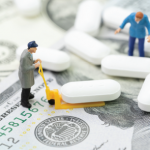(Reuters Health)—The U.S., which spends more on drugs than any other country, might contain costs by limiting market exclusivity for brand name medicines and changing coverage requirements for government health plans, some doctors argue.
Although brand-name drugs account for only 10% of all dispensed prescriptions in the U.S., they make up 72% of drug spending, doctors note in a paper published in JAMA on Aug. 23.
Between 2008 and 2015, prices for the most commonly used brand name drugs surged 164% in the U.S., far outstripping the 12% gain in the consumer price index, which measures what people pay for retail goods, Dr. Aaron Kesselheim of Brigham and Women’s Hospital and Harvard Medical School in Boston and colleagues point out in their paper.
“High prescription drug prices in the U.S. are due to a combination of the market exclusivity given to pharmaceutical manufacturers by patents and other U.S. laws that protect them from direct competition for years—potentially over a decade—after the drugs are first marketed, as well as limitations on payors’ ability to negotiate effectively either because they are restricted to do so by law or because there is not enough good comparative effectiveness information available,” Kesselheim says by email.
To assess the forces driving drug costs, Kesselheim and colleagues reviewed research published from 2005–2016 exploring the sources of drug prices in the U.S., the consequences and possible solutions.
In the U.S., per capita spending on prescription drugs was $858 as of 2013, more than twice the $400 average for 19 other industrialized nations, the analysis found.
List prices for the top 20 drugs by revenue help explain this chasm. Combined, average list prices for these drugs were three times greater in the U.S. than in the U.K.
Drug prices are higher in the U.S. than in the rest of the industrialized world because manufacturers set the prices. In many other countries, regulators negotiate prices or reject coverage of medications when they consider the price too high based on the amount of benefit patients might get from the treatment.
High prices can reflect the increasing cost and complexity of drug development, Kesselheim and colleagues concede.
But in the U.S., they are also the result of a regulatory system that protects brand name drugs from lower-cost generic competitors, coverage requirements for government-funded drug benefits and restrictions on how much public and private insurers can negotiate drug prices, the authors argue.
High prices were once limited mostly to brand name drugs for rare diseases. But drugs for common medical problems like diabetes and cancer now have high costs, too.


